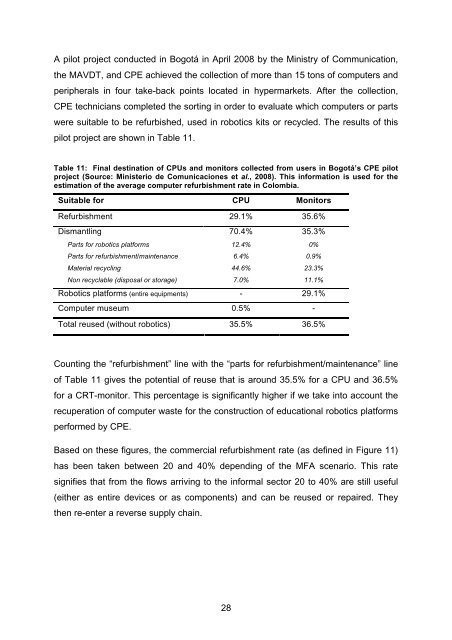10 07 29 Master thesis Juliana Leon - e-Waste. This guide
10 07 29 Master thesis Juliana Leon - e-Waste. This guide
10 07 29 Master thesis Juliana Leon - e-Waste. This guide
Create successful ePaper yourself
Turn your PDF publications into a flip-book with our unique Google optimized e-Paper software.
A pilot project conducted in Bogotá in April 2008 by the Ministry of Communication,<br />
the MAVDT, and CPE achieved the collection of more than 15 tons of computers and<br />
peripherals in four take-back points located in hypermarkets. After the collection,<br />
CPE technicians completed the sorting in order to evaluate which computers or parts<br />
were suitable to be refurbished, used in robotics kits or recycled. The results of this<br />
pilot project are shown in Table 11.<br />
Table 11: Final destination of CPUs and monitors collected from users in Bogotá’s CPE pilot<br />
project (Source: Ministerio de Comunicaciones et al., 2008). <strong>This</strong> information is used for the<br />
estimation of the average computer refurbishment rate in Colombia.<br />
Suitable for CPU Monitors<br />
Refurbishment <strong>29</strong>.1% 35.6%<br />
Dismantling 70.4% 35.3%<br />
Parts for robotics platforms 12.4% 0%<br />
Parts for refurbishment/maintenance 6.4% 0.9%<br />
Material recycling 44.6% 23.3%<br />
Non recyclable (disposal or storage) 7.0% 11.1%<br />
Robotics platforms (entire equipments) - <strong>29</strong>.1%<br />
Computer museum 0.5% -<br />
Total reused (without robotics) 35.5% 36.5%<br />
Counting the “refurbishment” line with the “parts for refurbishment/maintenance” line<br />
of Table 11 gives the potential of reuse that is around 35.5% for a CPU and 36.5%<br />
for a CRT-monitor. <strong>This</strong> percentage is significantly higher if we take into account the<br />
recuperation of computer waste for the construction of educational robotics platforms<br />
performed by CPE.<br />
Based on these figures, the commercial refurbishment rate (as defined in Figure 11)<br />
has been taken between 20 and 40% depending of the MFA scenario. <strong>This</strong> rate<br />
signifies that from the flows arriving to the informal sector 20 to 40% are still useful<br />
(either as entire devices or as components) and can be reused or repaired. They<br />
then re-enter a reverse supply chain.<br />
28
















